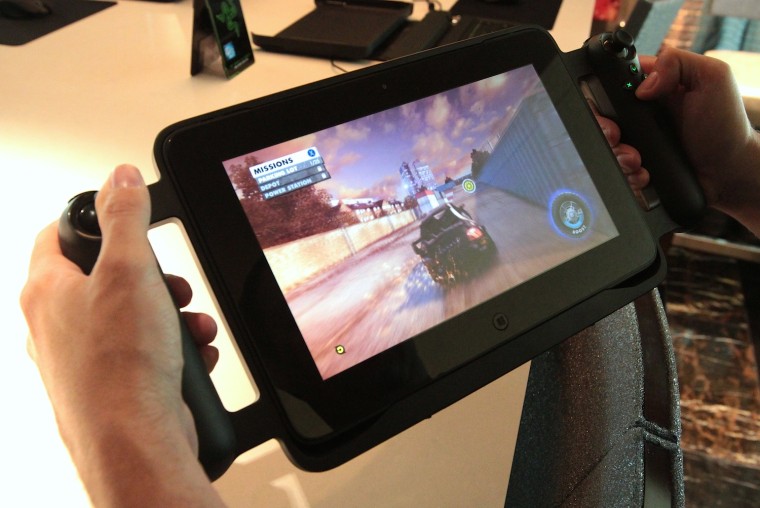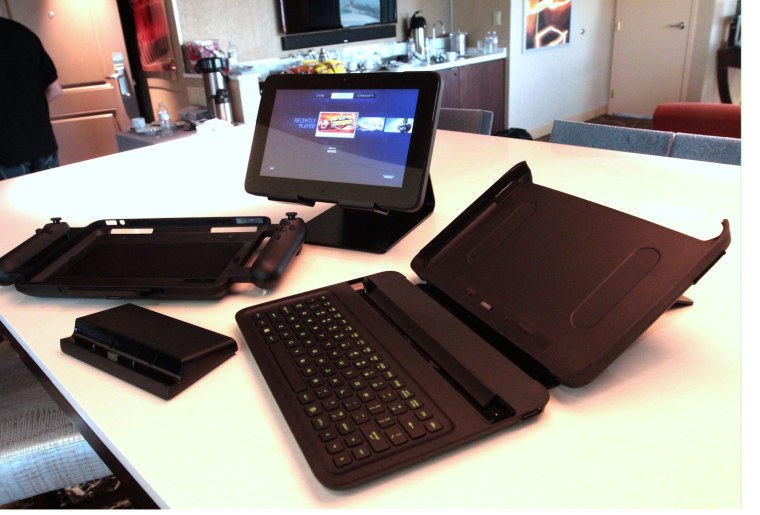
Razer's Project Fiona, a gaming tablet introduced as a concept at last year's CES, has become a reality at this year's. But it's not just a regular tablet with gaming accessories — it's a full-on gaming PC, and it can play anything your desktop can.
Gaming on tablets has been fairly limited — Angry Birds and Infinity Blade are good time-wasters, but the depth of console and PC games is missing, almost without exception. With Windows 8 focusing on the tablet form factor, Razer saw an opportunity to make a tablet that could play "real" games.
Its device was called "Project Fiona" when it was shown at CES 2012, but only as a concept. But after a wildly successful campaign on Facebook to determine interest, Razer decided to make it a reality.
The result is the Edge, and Razer has improved it with a whole ecosystem of accessories and features suggested by the community.
Project Fiona had controllers with analog sticks and buttons fused to the tablet itself; Razer decided to ditch that design and make the tablet fit into several possible configurations.

With the controller module, the Edge acts like the prototype, and is great for playing on the plane or train. With the keyboard dock, it essentially turns into a high-powered but compact laptop. And with the simple docking station, it can connect with controllers and your TV for the big-screen experience.
At Razer's CES suite, a visit to check out the device and its accessories was impressive. The amount of power Razer has packed into the tablet is unprecedented: Core i7 processor, 8 GB of RAM, 128 GB of storage, and a discrete graphics card. And it still weighs under 3 pounds!
The specs mean it can run pretty much any game, and the accessories mean you won't be playing a racer with the keyboard, or an MMO with analog sticks. That gives it a leg up on traditional laptops and other tablets. Of course, you can hook up any controller or keyboard you already own, too. After all, it's a PC.

The accessories felt solidly constructed, and they connect easily but securely to the tablet. Using Steam's Big Picture mode seemed second nature, and popping it on the TV was as easy as connecting an HDMI cable. It's a great way to get indie and Web-based games off your monitor and onto the big screen.
It's not all fun and games, though. First, there's the fact that very few games are optimized for touch controls, a situation that's getting better but still kind of a bummer for a gaming tablet.
The device also runs pretty hot. If I had it on my lap while playing a game, I can easily picture it getting a little uncomfortable, though it was nothing dangerous. That's just the facts when you have a high-powered CPU and GPU packed into such a tight space.

And of course it's a bit expensive. Razer is already a premium brand, and since there's not much on the market like the Edge, it's hard to say whether it's really too expensive. But the basic version with less graphics and computing power starts at $999, and the pro version (which is a worthwhile upgrade) is $1,299 (more spacious versions are forthcoming). Add on an accessory or two and you're looking at the price of a powerful laptop with a big screen, which may serve your gaming purposes better.
But price and other quibbles aside, the Edge is an interesting and well-executed device. It should be available within a month or two. More information and specs can be found at Razer's website.
Devin Coldewey is a contributing writer for NBC News Digital. His personal website is coldewey.cc.